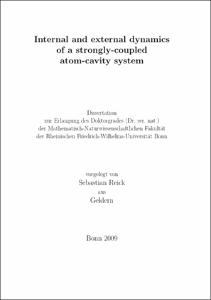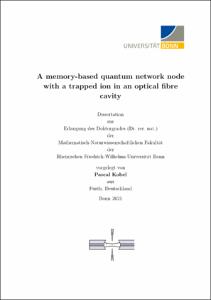Internal and external dynamics of a strongly-coupled atom-cavity system

Internal and external dynamics of a strongly-coupled atom-cavity system

| dc.contributor.advisor | Meschede, Dieter | |
| dc.contributor.author | Reick, Sebastian | |
| dc.date.accessioned | 2020-04-15T10:56:01Z | |
| dc.date.available | 2020-04-15T10:56:01Z | |
| dc.date.issued | 07.01.2010 | |
| dc.identifier.uri | https://hdl.handle.net/20.500.11811/4504 | |
| dc.description.abstract | A system comprised of a small number of neutral atoms coupled to the mode of a high finesse optical resonator is a model system to study light-matter interaction at the quantum level and to explore fundamental effects like the influence of the measurement process on the atomic state. Promising proposals to generate entangled states in such systems are based on the simultaneous coupling of two atoms to one resonator mode. In chapter 1 of this thesis I shortly summarise the experimental tools to capture, trap, and transport single atoms using a magneto-optical trap and an optical conveyor belt. I discuss theoretical foundations to describe our system and present numerical simulations, the results of which enter the analysis of our experimental data. The average atom-cavity coupling strength is deduced from the measured cavity transmission and compared to a model taking atomic motion into account. The dynamics of the hyperfine spin state of one and two coupled atoms is the focus of chapter 2. I describe a nondestructive cavity-based state detection method, quantify the state detection fidelity, and identify optimum experimental parameters. This method is then used to record random telegraph signals, exhibiting quantum jumps on a timescale of milliseconds. Telegraph signals for two atoms are analysed employing Bayesian statistics, yielding additional information on the evolution of the hyperfine states. A good localisation of the atom is necessary to achieve stable coupling to the cavity mode. In chapter 3, I discuss two different aspects of how the motion of the atom can be controlled. Firstly an intracavity dipole trap is characterised and it is shown that it results in improved confinement of the atom. Secondly I examine the dependence of cavity-cooling forces on our experimental parameters and compare two different cooling regimes. | en |
| dc.description.abstract | Interne und externe Dynamik eines stark gekoppelten Atom-Resonator-Systems Einige wenige Atome, die an das Feld eines optischen Resonators hoher Finesse gekoppelt sind, stellen ein Modellsystem zur Untersuchung von fundamentalen Prozessen der Licht-Materie-Wechselwirkung dar, wie etwa die Rückwirkung des quantenmechanischen Messprozesses auf den atomaren Zustand. Vielversprechende Vorschläge zur Erzeugung von verschränkten Zuständen in solchen Atom-Resonator-Systemen basieren auf der simultanen Wechselwirkung zweier Atome mit dem Resonatorfeld. Im ersten Kapitel dieser Arbeit fasse ich die wesentlichen Komponenten des experimentellen Aufbaus zusammen. Theoretische Grundlagen zur Beschreibung des Systems werden diskutiert, sowie darauf aufbauende numerische Simulationen, deren Ergebnisse in spätere Auswertungen von Messergebnissen eingehen. Den Abschluss des Kapitels bildet eine Bestimmung der mittleren Atom-Resonator-Kopplungsstärke und deren Vergleich mit einem theoretischen Modell, welches die atomare Bewegung berücksichtigt. Die Dynamik der internen Hyperfein-Spinzustände bildet den Schwerpunkt des zweiten Kapitels. Eine nicht-destruktive Methode zur Messung des Spins mit Hilfe der Cavity wird vorgestellt und charakterisiert; dabei werden optimale experimentelle Parameter identifiziert. Mit Hilfe dieser Methode wurden sog. Telegraphen-Signale aufgenommen, bei denen Quantensprünge auf der Zeitskala einiger Millisekunden beobachtet werden können. Im Falle zweier Atome werden derartige Signale zusätzlich mittels Bayes'scher Statistik analysiert um Informationen über die zeitliche Entwicklung der Spinzustände zu erhalten. Eine wichtige Voraussetzung für stabile Atom-Resonator-Kopplung ist eine gute Lokalisierung der Atome. Im dritten Kapitel werden zwei Phänomene diskutiert welche die Bewegung der Atome beeinflussen. Zum einen wird gezeigt, wie eine innerhalb des Resonators gebildete zusätzliche Dipolfalle zu einer verbesserten Lokalisierung führt. Des Weiteren wird theoretisch und experimentell untersucht, wie Kühleffekte, die ausschließlich auf der Atom-Resonator-Wechselwirkung basieren, von der Wahl der experimentellen Parameter abhängen. | en |
| dc.language.iso | eng | |
| dc.rights | In Copyright | |
| dc.rights.uri | http://rightsstatements.org/vocab/InC/1.0/ | |
| dc.subject | Atomphysik | |
| dc.subject | Laserkühlung | |
| dc.subject | Quantenelektrodynamik | |
| dc.subject | Quantenoptik | |
| dc.subject | Lichtkraft | |
| dc.subject | Quantensprung | |
| dc.subject | Bayes-Verfahren | |
| dc.subject | Atoms molecules and ions in cavities | |
| dc.subject | Quantum optics | |
| dc.subject | Quantum fluctuations | |
| dc.subject | quantum noise | |
| dc.subject | quantum jumps | |
| dc.subject | Cavity quantum electrodynamics micromasers | |
| dc.subject | Mechanical effects of light on atoms molecules and ions | |
| dc.subject.ddc | 530 Physik | |
| dc.title | Internal and external dynamics of a strongly-coupled atom-cavity system | |
| dc.type | Dissertation oder Habilitation | |
| dc.publisher.name | Universitäts- und Landesbibliothek Bonn | |
| dc.publisher.location | Bonn | |
| dc.rights.accessRights | openAccess | |
| dc.identifier.urn | https://nbn-resolving.org/urn:nbn:de:hbz:5N-19901 | |
| ulbbn.pubtype | Erstveröffentlichung | |
| ulbbnediss.affiliation.name | Rheinische Friedrich-Wilhelms-Universität Bonn | |
| ulbbnediss.affiliation.location | Bonn | |
| ulbbnediss.thesis.level | Dissertation | |
| ulbbnediss.dissID | 1990 | |
| ulbbnediss.date.accepted | 16.12.2009 | |
| ulbbnediss.fakultaet | Mathematisch-Naturwissenschaftliche Fakultät | |
| dc.contributor.coReferee | Weitz, Martin |
Files in this item
This item appears in the following Collection(s)
-
E-Dissertationen (4373)







